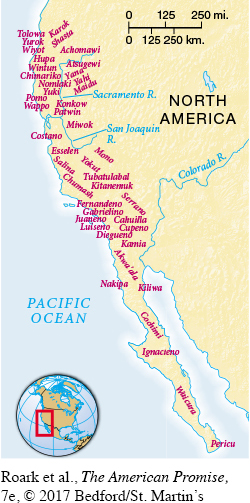The American Promise: Printed Page 10
The American Promise, Value Edition: Printed Page 9
The American Promise: A Concise History: Printed Page 11
Pacific Coast Cultures

The richness of the natural environment made present-
The Chumash, one of the many California cultures, emerged in the region surrounding what is now Santa Barbara about 5000 BP. Comparatively plentiful food resources—
The American Promise: Printed Page 10
The American Promise, Value Edition: Printed Page 9
The American Promise: A Concise History: Printed Page 11
Page 11Another rich natural environment lay along the Pacific Northwest coast. Like the Chumash, Northwest peoples built more or less permanent villages. After about 5500 BP, they concentrated on catching whales and large quantities of salmon, halibut, and other fish, which they dried to last throughout the year. They also traded with people who lived hundreds of miles from the coast. Fishing freed Northwest peoples to develop sophisticated woodworking skills. They fashioned elaborate wood carvings that denoted wealth and status, as well as huge canoes for fishing, hunting, and conducting warfare against neighboring tribes. Archaic northwesterners often fought with one another over access to prime fishing sites.